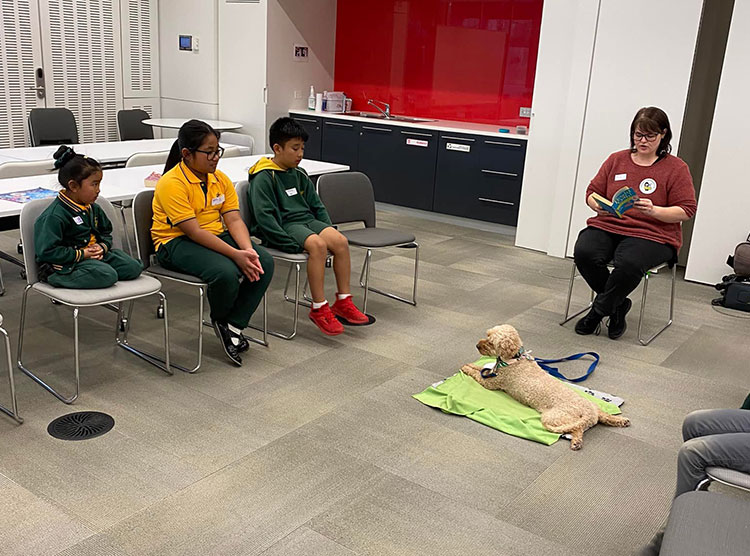
Our Blog
A non-negotiable in our industry - The Therapy dog must be safe with the children

Our tutors are seeing teachers taking their family dogs into school more and more. Although on face value, that seems like a fantastic idea. We really want to warn people that the difference between a therapy dog and a family dog should be clear. A school is not a place where dogs should 'learn' to be therapy dogs, students are not props that can be practised with. Dog training and handler education are considerable endeavours and must be taken very seriously - the risks dog, child, the school's reputation and the teacher's future professional prospects are too great to be taking chances with.
So, how does Canine Comprehension do it?
When considering how safe a dog is for work with children, especially in high distraction environments such as schools, one must really know how to read the finer details of dog body language to be able to judge if the dog in question does have the right temperament and training for every situation they find themselves in. For instance, many people think their dogs would be safe in a classroom or school playground because they are good with the children in the family and home environment. Therapy dogs working in schools must be tested in situations where there is a great deal of noise, a lot of movement, different smells and foods as distractions, as well as having a handler who is focused both on the dog and on the children. Even if a therapy dog has worked in environments such as nursing homes and hospitals, a school is yet a very different challenge. There is a saying in dog training: “Untrained is unknown.” and if the handler hasn’t trained for a busy school environment they simply do not know if their dog would be suited to and safe for such work.
When a dog is overwhelmed by noise, movement and smells they can experience sensory overload and trigger stacking. It is difficult for a dog who is not familiar with this situation to react accordingly to its handler’s commands. Imagine an unusually friendly dog, on lead who is feeling anxious. Like all animals in a perceived threatening situation, they have three choices: Fight, Flight or Freeze. Flight has been taken away due to the restraints of the lead. The dog could freeze, try to avoid the situation and have the anxiety build. Or, they could try to ‘take control of the situation by barking, growling, lunging or biting. One reaction is not fair or ethical for the dog, the other is disastrous for the children in contact with the dog. When handlers, who are not able to read dog body language put their dogs into situations where the dog is stressed, there will inevitably be a situation where the overwhelmed dog feels they have to hide, anxiously avoid or aggressively defend themselves.
“Dog bites do not come out of the blue - they occur when handlers are not paying attention, or do not know what behaviour to pay attention to in the first place.”
It is simply a fact that most people working in schools are not unusually dog trainers. They are not expected to be able to read all of the subtle signs that dogs show when intimidated or needing a break. Reading dog body language goes much further than looking at a wagging or tucked tail. Trainers are taught to look at subtle eye movements, avoidance, repetitive habits, back straightening and different types of panting behaviour. Those who have dogs in schools need to become their dog's trainers - they need to have the skills to both observe accurately and positively teach the dog what is expected of them.
All tutors at Canine Comprehension have either initially studied an AAT certification elsewhere or have completed our own ‘Pathway to Employment’ AAT course with the company as well as training and testing with Dogmanship Training. A rigorous AAT course should provide a comprehensive background to Therapy-Dog training covering handling, socialisation, psychology, body language, and promoting good behaviour. It should also provide information to fully understand Animal-Assisted Interventions, including how Human-Animal Interactions (HAI) are beneficial, how to manage ethical and legal issues, and understand occupational health and safety. At the end of a course, participants should have the confidence and skills to begin working with their dogs in school settings.
All Canine Comprehension therapy dogs are expected to be able to sit on command, hold a drop-stay for up to an hour at a time, walk on a loose lead, understand food refusal and demonstrate a number of trick training exercises. These expectations should be met under distraction, as that is how the dog will need to behave in school. Canine Comprehension human/dog teams are expected to find novel settings for training such as city walks, sports days, festivals, cafes etc. All of this training not only helps normalise high-energy experiences for the dog but also allows the handler and dog to communicate effectively in busy environments, such as a school.
We have other resources and contacts that can help you navigate training a therapy dog to work in schools, please book a free chat with our CEO to discuss your options.
Or, book our services - all of the doggy benefits with the training and risk mitigation already done for you!
